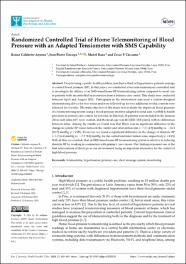Mostrar el registro sencillo del ítem
“Randomized Controlled Trial of Home Telemonitoring of Blood Pressure with an Adapted Tensiometer with SMS Capability“
| dc.contributor.author | Calderón-Anyosa, Renzo | |
| dc.contributor.author | Pierre Tincopa, Jean | |
| dc.contributor.author | Raza, Mabel | |
| dc.contributor.author | Cárcamo, Cesar P. | |
| dc.date.accessioned | 2023-05-22T15:05:12Z | |
| dc.date.available | 2023-05-22T15:05:12Z | |
| dc.date.issued | 2023-02-12 | |
| dc.identifier.uri | https://hdl.handle.net/20.500.13053/8604 | |
| dc.description.abstract | “: Despite being a public health problem, less than a third of hypertensive patients manage to control blood pressure (BP). In this paper, we conducted a two-arm randomized controlled trial to investigate the efficacy of an SMS-based home BP telemonitoring system compared to usual care in patients with uncontrolled hypertension from a primary care center. This study was conducted between April and August 2018. Participants in the intervention arm used a custom-designed telemonitoring device for two weeks and were followed up for two additional weeks; controls were followed for 4 weeks. The main objective of this study is to evaluate the impact on blood pressure of a telemonitoring system using a blood pressure monitor adapted to send data via SMS to health providers in primary care centers for 4 weeks. In this trial, 38 patients were included in the analysis (18 in each arm), 68% were women, and the mean age was 68.1 [SD: 10.8 years], with no differences between arms. Among the results we found was that There was no significant difference in the change in systolic BP values between the control and intervention arm (−7.2 [14.9] mmHg vs. −16.3 [16.7] mmHg; p = 0.09). However, we found a significant difference in the change of diastolic BP (−1.2 [6.4] mmHg vs. −7.2 [9.8] mmHg; for the control and intervention arms, respectively p = 0.03). With all this, we conclude that an SMS-based home BP telemonitoring system is effective in reducing diastolic BP by working in conjunction with primary care centers. Our findings represent one of the first interventions of this type in our environment, being an important alternative for the control of high blood pressure.“ | es_PE |
| dc.format | application/pdf | es_PE |
| dc.language.iso | eng | es_PE |
| dc.publisher | MDPI | es_PE |
| dc.rights | info:eu-repo/semantics/openAccess | es_PE |
| dc.rights.uri | https://creativecommons.org/licenses/by/4.0/ | es_PE |
| dc.subject | telemedicine; hypertension; primary care; short message system; monitoring | es_PE |
| dc.title | “Randomized Controlled Trial of Home Telemonitoring of Blood Pressure with an Adapted Tensiometer with SMS Capability“ | es_PE |
| dc.type | info:eu-repo/semantics/article | es_PE |
| dc.identifier.doi | "https://doi.org/ 10.3390/ejihpe13020033 " | |
| dc.type.version | info:eu-repo/semantics/publishedVersion | es_PE |
| dc.publisher.country | CH | es_PE |
| dc.subject.ocde | 3.00.00 -- Ciencias médicas, Ciencias de la salud | es_PE |
Ficheros en el ítem
Este ítem aparece en la(s) siguiente(s) colección(es)
-
SCOPUS [380]


